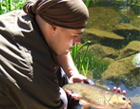
Ten Natural Tinder Types and How to Prepare Them
Fire-lighting is the bushcraft skill that most newcomers are eager to learn and perfect, but no matter how good your fire drill, or fire plough skills are, it will mean nothing without the correct tinder to convert your ember into a bundle of flames. Below I have included (in no particular order) ten of the most commonly found and used naturally occurring types of tinder and how (if need be) to prepare them to make the most of them when it matters.
Dry Grass

Probably the most abundant natural tinder found in the majority of environments within the British Isles. Dry grass is one of the least effective types of tinder that I’ve included here if being used purely with a spark – but if you have a red hot ember ready to add to a good sized bundle then it can be one of the best for keeping a flame burning larger and longer if it’s prepared correctly. To get the most from this tinder the grass needs to be dead, and bone dry and will benefit with some roughing up to loosen the fibres. If, when collected the grass is damp then sprinkle it over some prickly shrubbery on a warm day, such as bramble where it will be held in place even if windy and it will dry nicely in the warmth of the sun. Long dead grass is best found around other vegetation where it loses out in its search for light, so is best collected from the edges of larger plants or trees where it grows to a large size before being starved of light and or water, leaving it dead, brown and if you’re luck, dry too.
Cramp Ball

Also known as King Alfred’s Cakes these unusual, almost charcoal-like fungi are most frequently found on dead or dying Ash trees. They almost look like dogs noses, but once removed from their resting place they act as a fantastic fire lighting tool. I say tool because once they are burning they will remain smouldering for a long time and may be used like a primitive portable lighter. To prepare them you may not need to do anything if they are very dry, but they usually benefit from drying in the open air once removed. Once dry they will happily take a spark or an ember and are one of the most convenient forms of tinder, but please only ever take when you need. Sadly some so called ‘bushcrafters’ are pilfering these on mass for the British Countryside resulting in them disappearing from certain areas. Taking care of the environment is the number one priority for any ‘true’ bushcrafter.
Bracket Fungus

There are several bracket funguses that are useable with primitive firesteels. The tinder produced by bracket fungi is commonly known as ‘amadou’. As the name suggests, a ‘bracket’ fungus is found growing from a tree trunk, they look much like natural shelves. Experiment with these and see how you find them to work. It’s the fleecy layer between the pore tubes and the cuticle that you’re looking for.
Punk

A strange name, maybe, but ‘punk’ can be useful. Punk is the spongy dry and dead wood that you sometimes see on sticks and stumps. If sufficiently dry you should be able to scrape it away with your finger nail. Punk may be used with firesteels, but watch it doesn’t blow away!
Birch Bark

Possibly the favourite tinder for most bushcrafters. Birch naturally sheds its flaky bark to keep the trunks white and able to reflect the light from the sun. Peel the already shedding bark and keep some inside your pocket. Only ever take the bark that is already falling away. If you remove the bark that is not ready to come off you will harm the tree and also be left with a worthless chunk of tinder as it will be too thick and slightly damp. I’ve seen some poor trees that have been killed thanks to careless individuals stripping them of bark without any regard to their welfare – truly shameful.
Birch bark is fantastic for use with firesteels and will work when wet due to the high content of naturally occurring oils. It’s also a fantastic material to make a tinder pot from – you can even make birch bark tar from it.
Clematis

Also known as Old Man’s Beard, this is excellent tinder, but it will burn quickly – so be ready! There is no preparation of the fluffy seed heads as such, just ensure that they are dry. The bark once removed from the stems is however an excellent addition to the fluffy seed heads as it burns longer. This tinder is excellent for use with firesteels.
Rosebay Willow Herb

Also known as Fireweed this is a common plant in many parts of the world. Once the seed-heads appear collect lots of them and use with a firesteel. I find that they work less well than similar alternatives as they tend to hold onto moisture more than others.
Thistle

It’s once again the fluffy tops that you want to collect. They burn very quickly, but can be collected in bulk and stored for use later. Again, as with all tinder, just make sure it’s dry and I find it works better if mixed with slower burning tinder to give you more working time.
Honeysuckle

It’s once again the fluffy tops that you want to collect. They burn very quickly, but can be collected in bulk and stored for use later. Again, as with all tinder, just make sure it’s dry and I find it works better if mixed with slower burning tinder to give you more working time.
Dead Bracken

This is usually very abundant in woodlands and woodland edges. Once it’s dead and bronzy in colour strip the leaves from the stems and use when lighting fires using friction.


COMMENTS
LEAVE YOUR OWN COMMENT